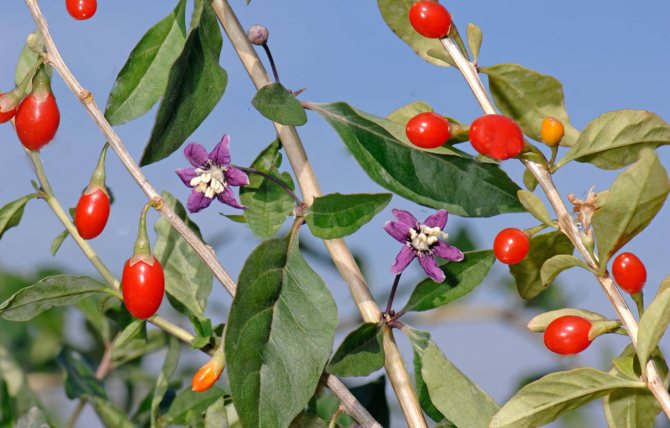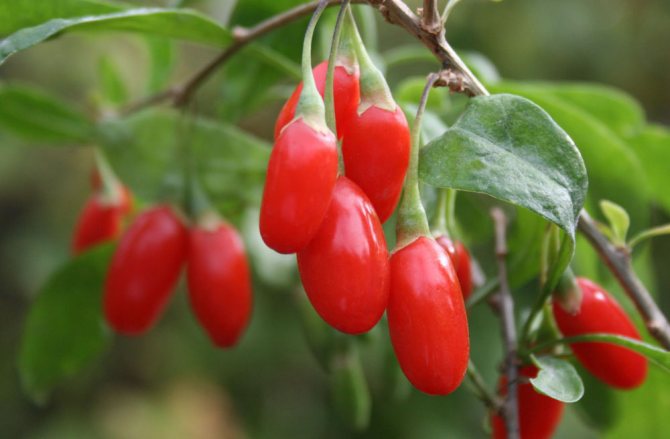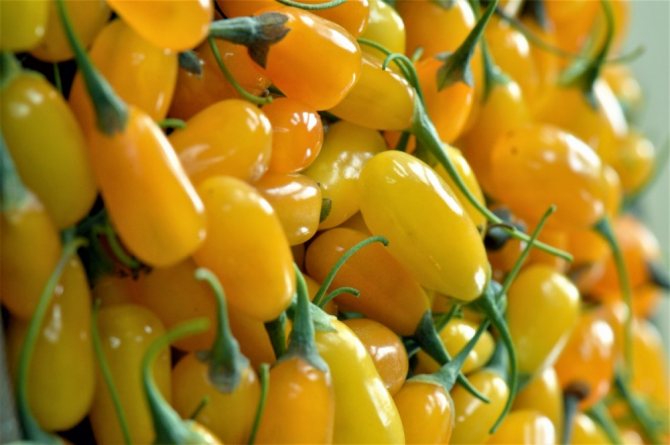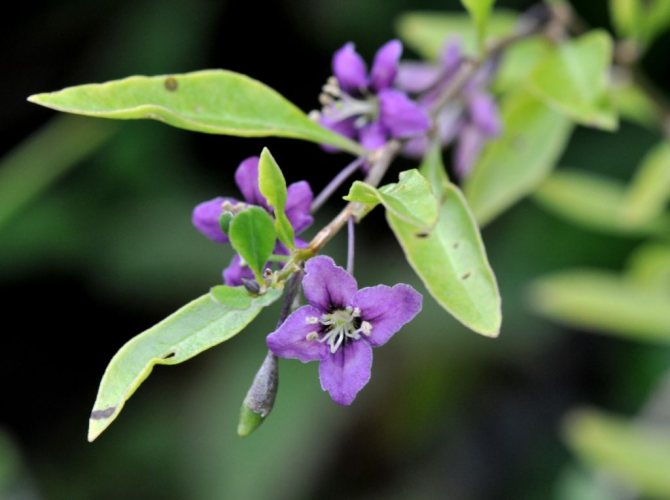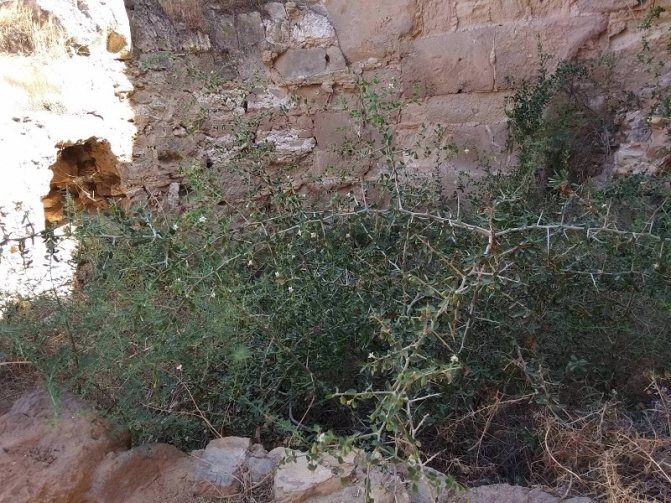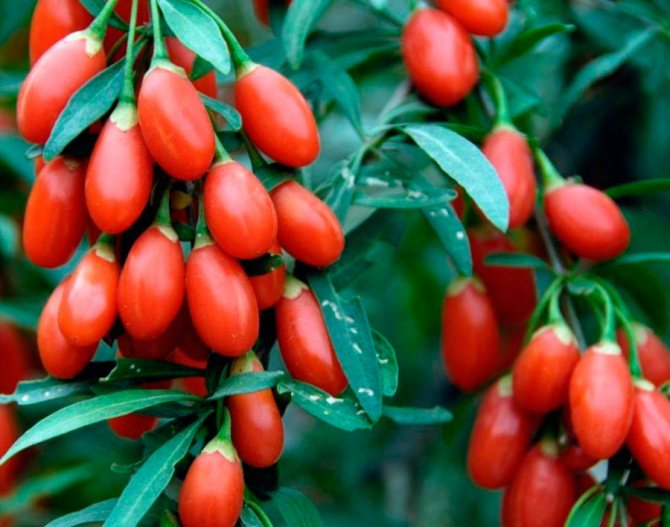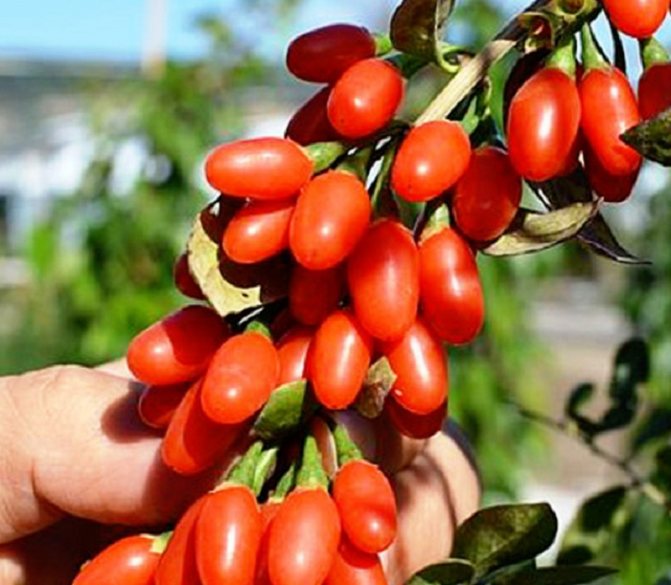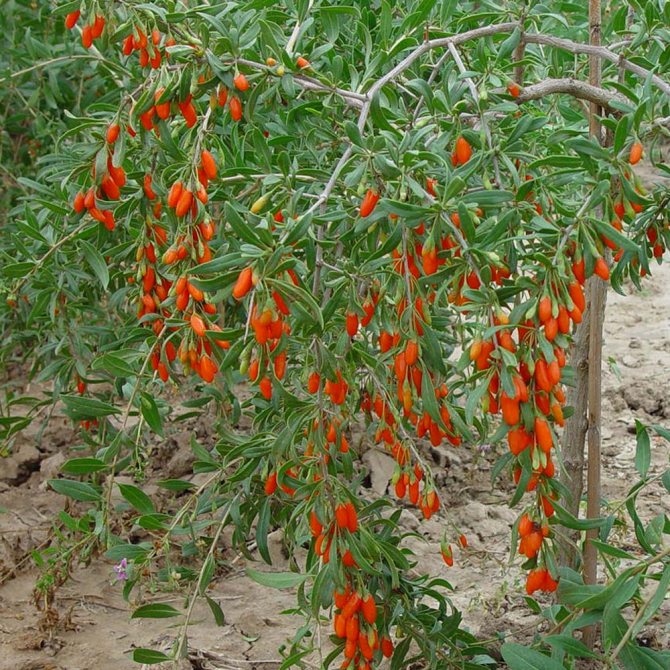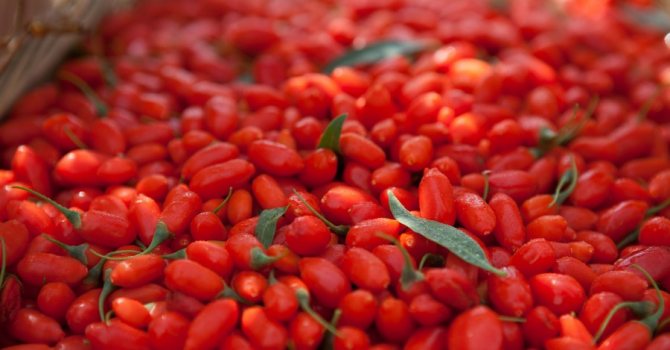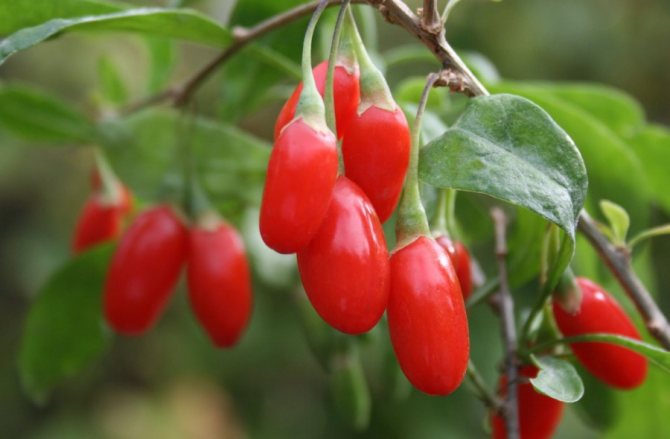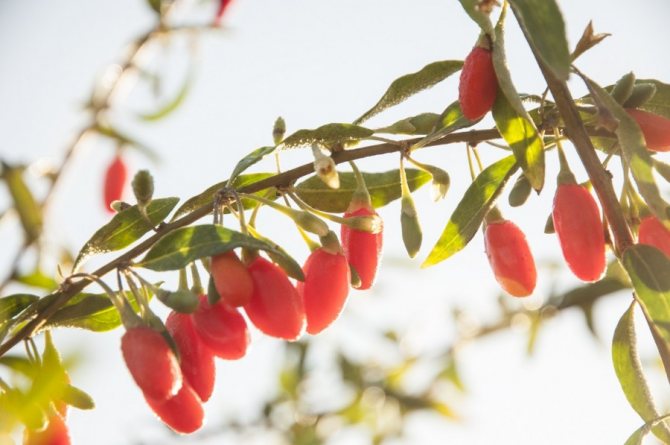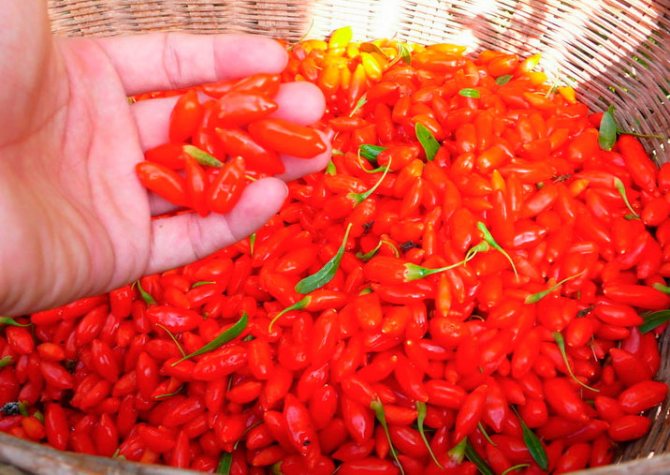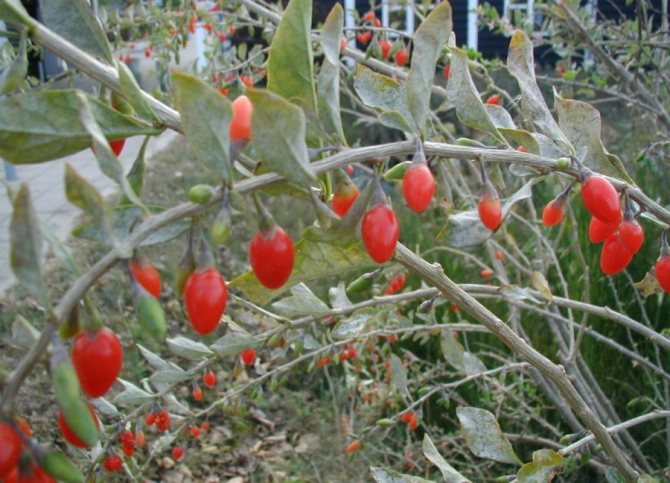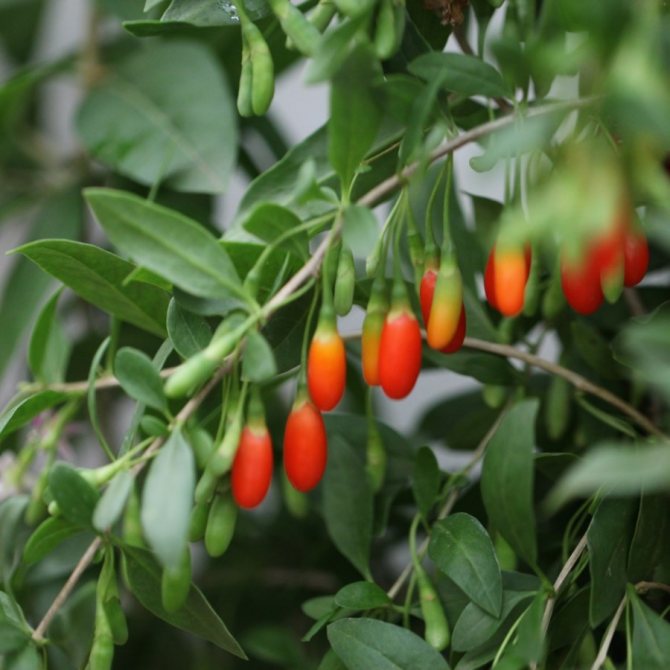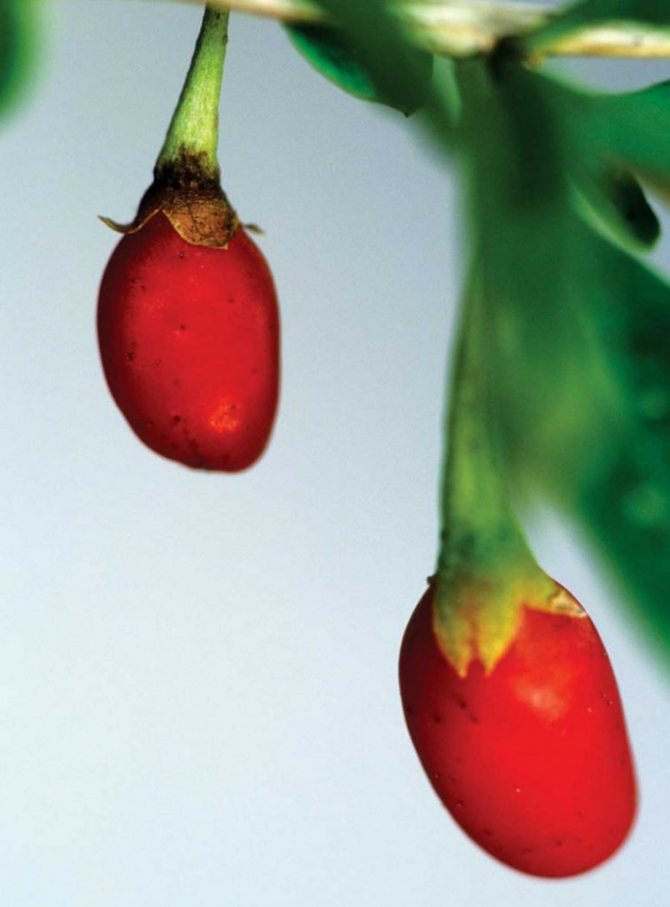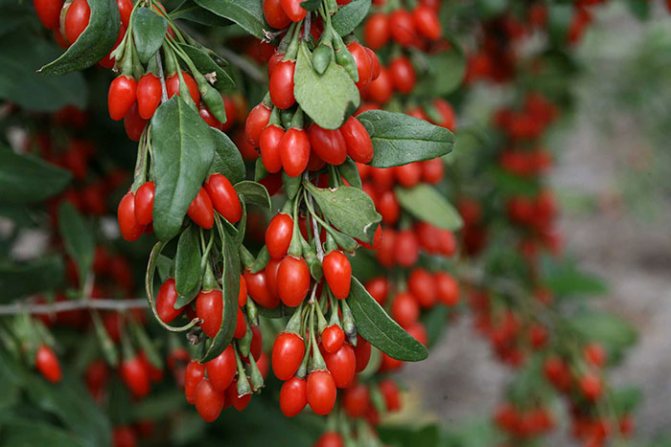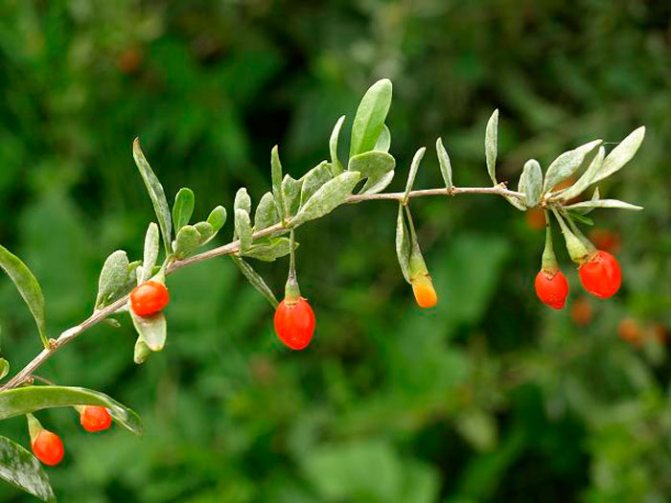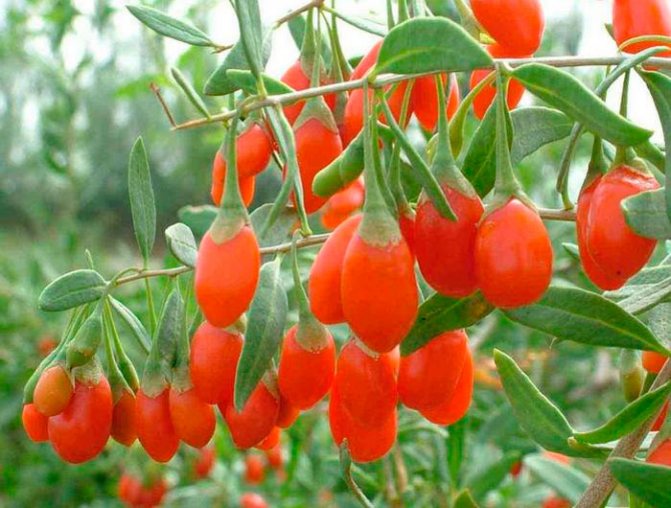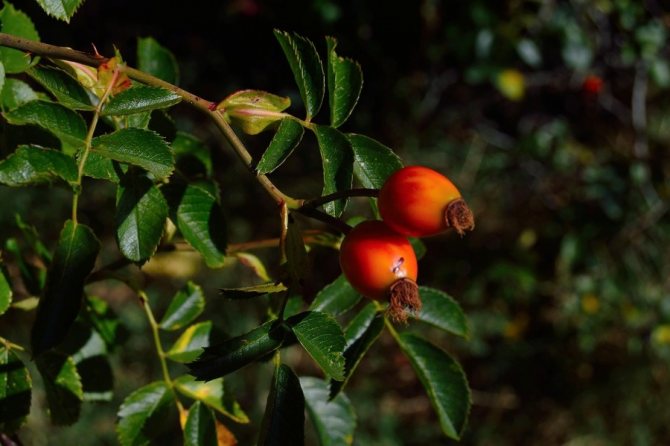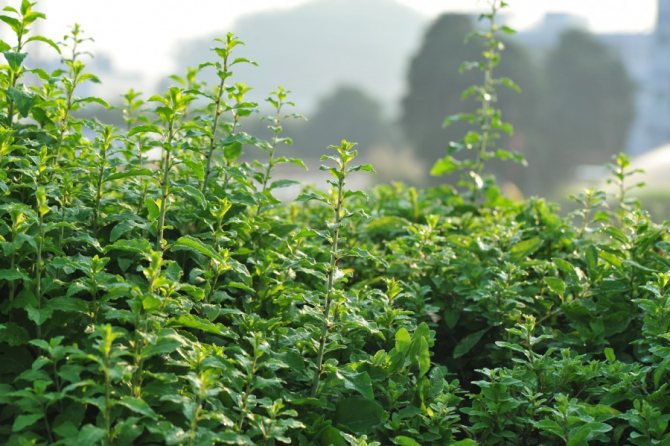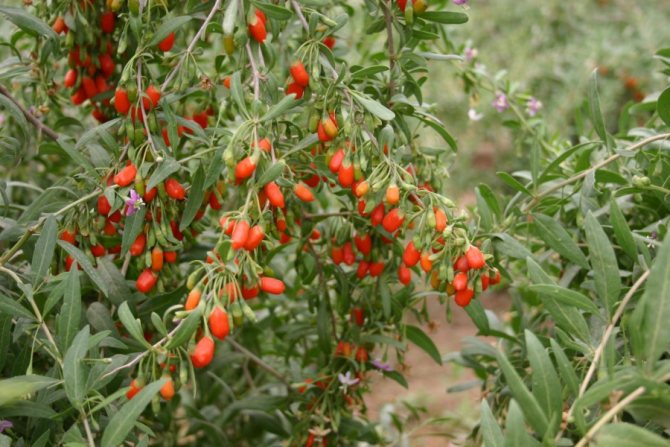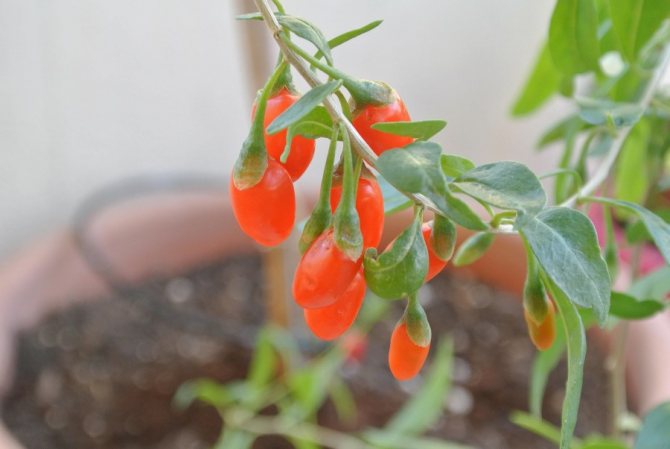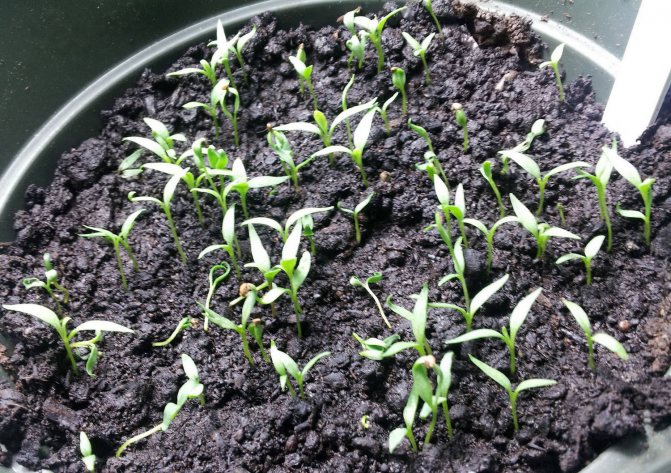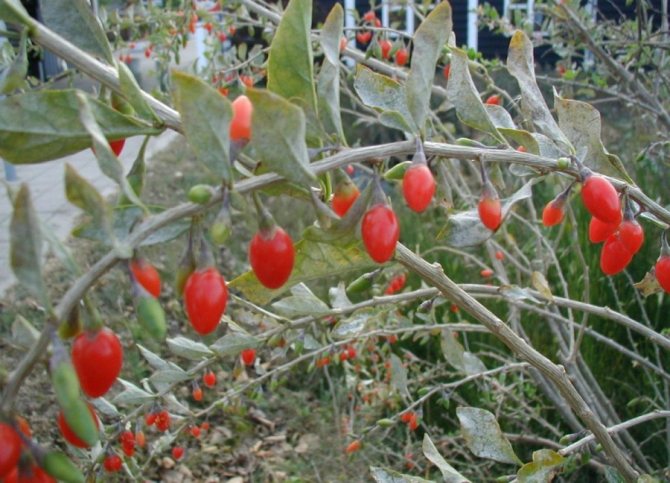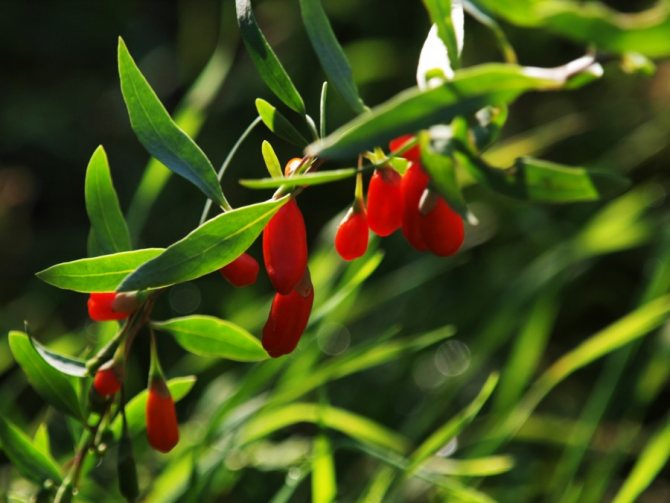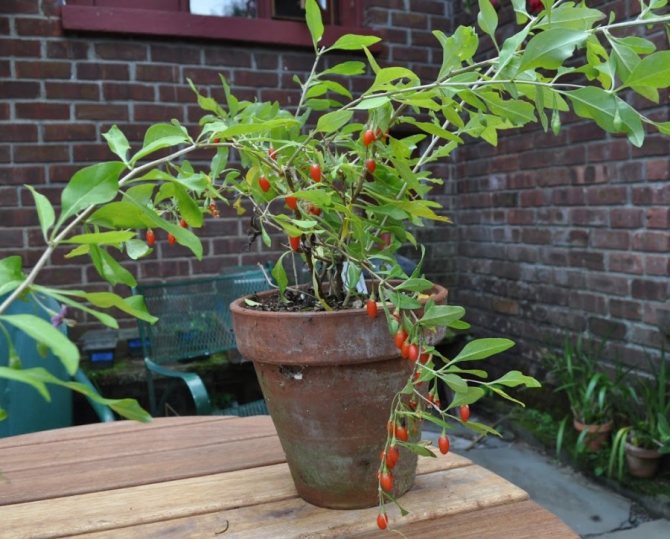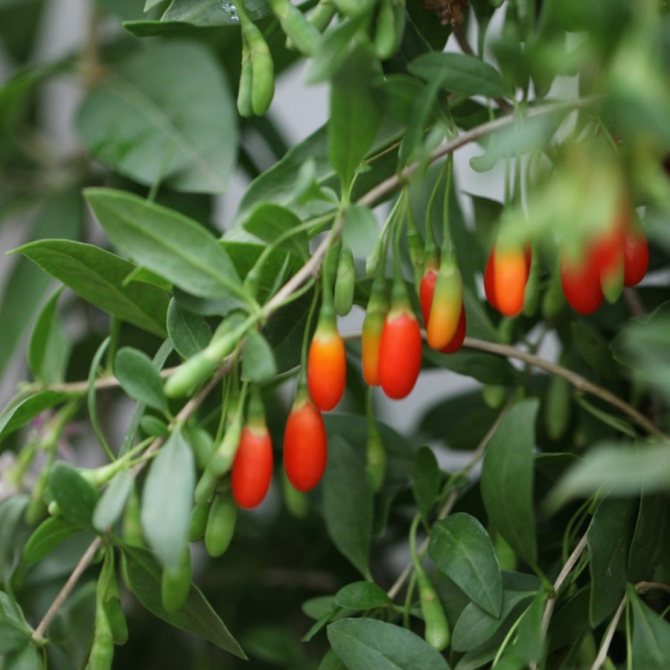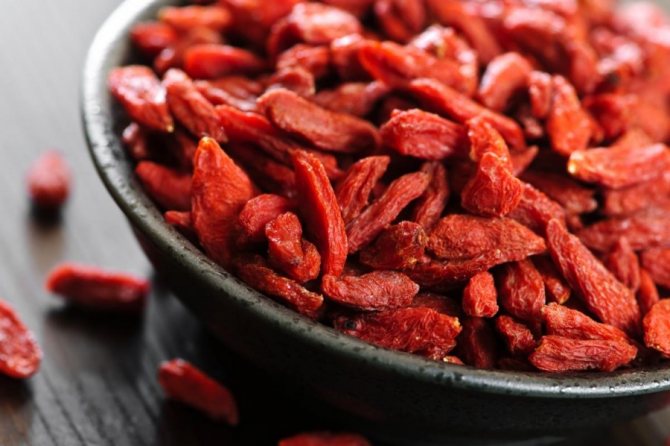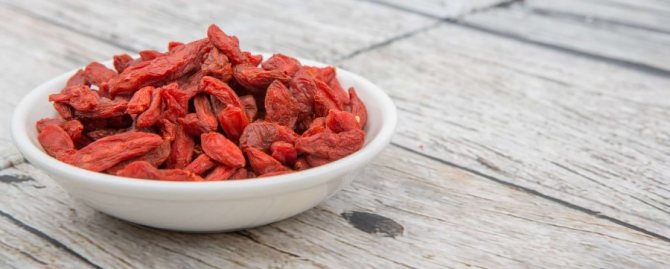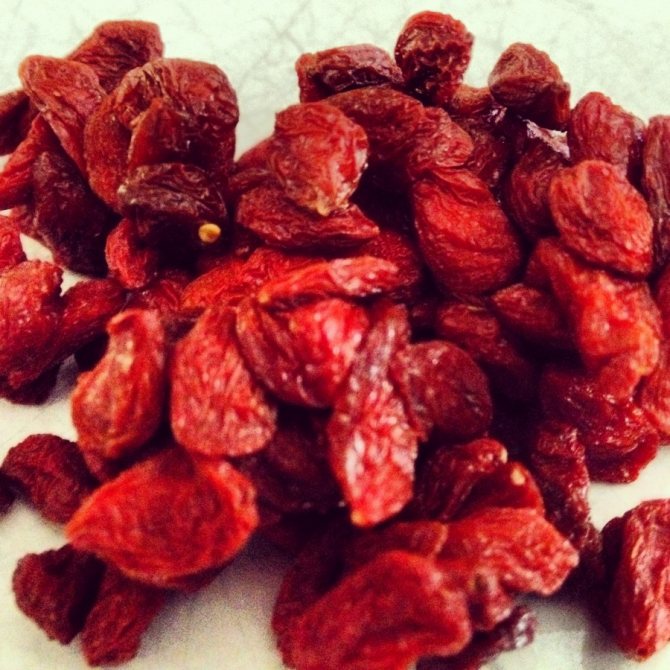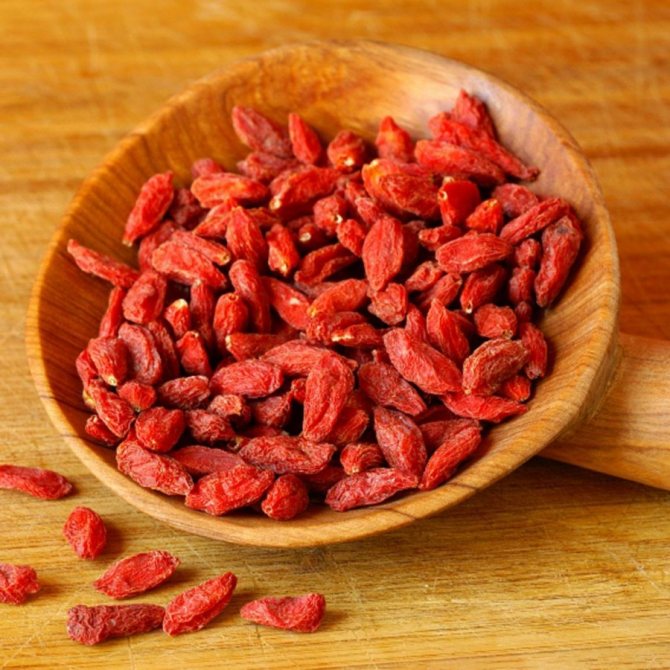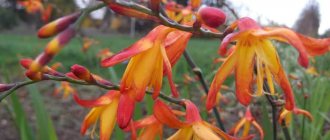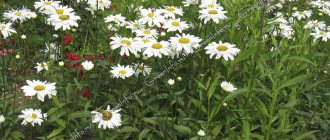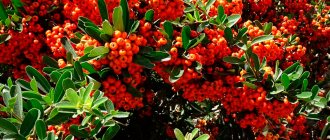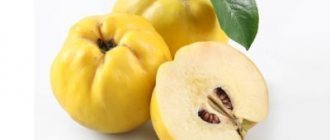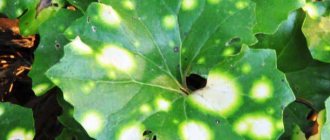There is such a legend: a long time ago, almost 500 years BC. a peasant lived in one of the Chinese provinces on the southern slope of the Fragrant Mountain. In his younger years, he met a girl, fell in love with her, and they got married. They were a hardworking couple with loving hearts. They lived a quiet and modest life until Gou Tzu (that was the name of the peasant) was drafted into the army to defend their homeland from the invasion of enemies.
When Gou Tzu, having fulfilled his sacred duty, returned home, he saw terrible devastation and devastation in his native village. Many fellow villagers were dying of hunger. Everyone knows very well what terrible consequences wars have led, are and will continue to lead. And the further, the consequences of the wars will get worse and worse.
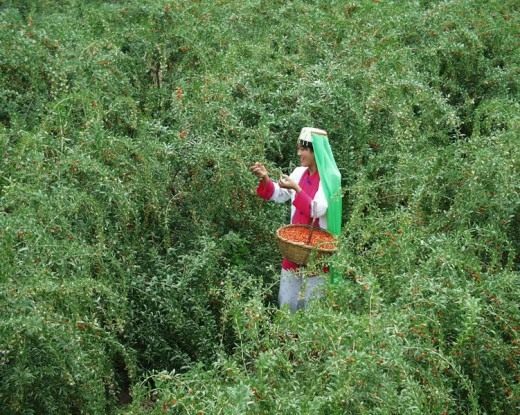
Collecting Goji berries, or Dereza vulgaris
However, when Gou Tzu entered his house, he was very surprised to see that his wife and mother were in good health and looked great. When her husband asked what was the reason for their good health among the many sick and starving fellow villagers, the wife replied: “All the time when there was nothing to eat, I picked berries from the thorny bushes that grow on Aromatnaya Mountain and fed them the whole family. " Gou Tzu was so happy and moved that he began to cry. When the neighbors learned this story, they too began to pick these red berries to save their families from disease and starvation. Since then, people began to call these miraculous berries "Gou Tsi" as if in memory of this amiable couple, who discovered and presented them with this fruit with such extraordinary nutritional value.
Dereza is common. Culture characteristics
The goji plant (common Dereza) is a low-growing shrub belonging to the Solanaceae family. The plant is cultivated in various countries. Consider where the common wolfberry grows. So, the culture can be found in China, in Asia, in the Kuban, in the Caucasus, in Ukraine and in some regions of Russia.
The common wolfberry shrub has the following distinctive characteristics:
- The fragile shoots of this culture are covered with thin thorns. The branches reach about 340 cm in length and hang down. They have a yellowish tint. Due to the beautiful color scheme of the plant, it is considered to be an ornamental species.
- The bark is usually gray in color.
- During flowering, the flowers are purple or pale pink. The mild aroma of flowers is also noteworthy, thanks to which the wolfberry is popular among gardeners and summer residents.
- Goji fruits are usually small in size, up to one and a half centimeters in length, they are bright red or orange in color. The appearance of fruits can be expected 2-3 years after planting the crop on the site.
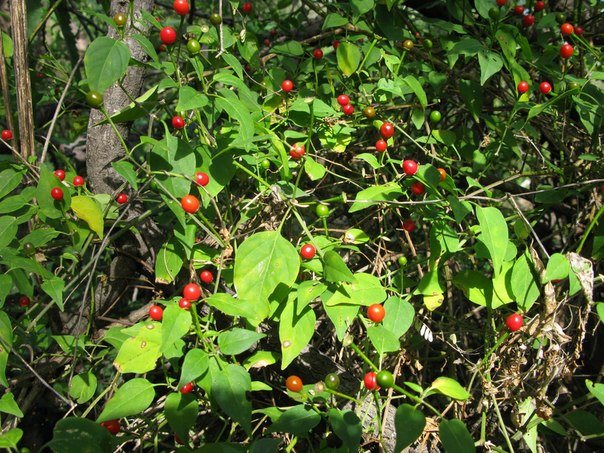

- The berries of the common wolfberry are quite juicy. It should be noted that in no case should they be eaten raw. Therefore, the fruits are usually dried in the shade, only after drying can they be consumed. The dry berries taste sweet and salty, sometimes sour. They taste the same as nightshade.
- These berries contain a very large amount of various nutrients, vitamins, calcium, antioxidants, zinc, phosphorus, iron and other useful components.
- The diameter of the crown of Dereza bushes is about 600 cm.
- The plant has a large root with many branches. Due to the massive root system, the crop can not be planted on all types of soil.
- Dereza leaves have a beautiful shade. From above they are painted green, and from below they are gray. The shape of the leaves is elongated, oblong.
- Dereza saplings begin their flowering from the beginning of summer. The culture pleases with its flowering throughout the summer. In the month of September, after the plant has faded, fruit can be expected to appear.
How to dry goji berries at home
In order for the berries to be stored for a long time, they must be dried on the same day after picking. It is possible to carry out drying of fruits at home using an automatic dryer of the "Veterok" type. Drying on the window is also possible: a newspaper is spread out, ripe fruits are gently poured onto it in a thin layer.
Goji berries: benefits and harms, how to take
You can also use the oven, the main thing is to make sure that there is the weakest fire there, otherwise the fruits can be burned. It is desirable that the gas stove be equipped with a convenient indicator of the temperature in the oven, then it will be easier to control the drying process.
Keep in mind the following:
- the surface intended for preserving berries must be absolutely dry;
- the fruits must be spread over the surface in an even thin layer;
- before drying, the berries are sorted out, rotten and unripe are removed, and debris and dried leaves are also removed;
- ready-made raw materials for the preparation of medicines are sorted out again and stored in canvas bags.
Note! It is not recommended to store raw materials in a plastic bag; dried fruits can quickly deteriorate. Preparing medicinal decoctions and infusions should be strictly according to the recipe, observing the recommended dosage.
Dereza varieties
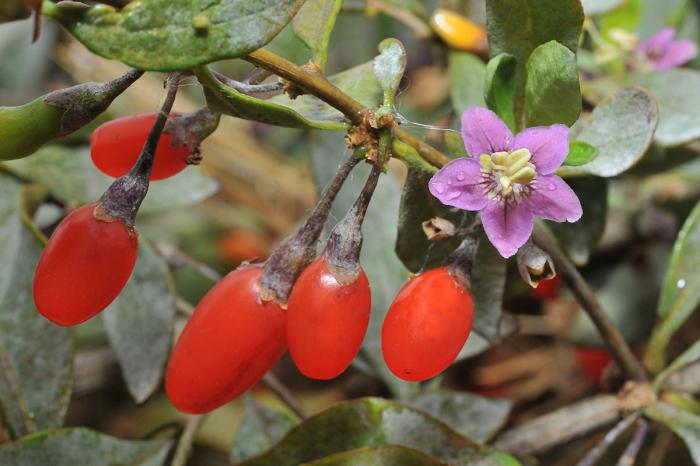

There are several of the most popular ornamental crop varieties:
- NEW BIG. It is also called "Polish Dereza". The berries of this cultivar have not a traditional oblong shape, but a round one. The fruits are sweet and fairly large in size. During the flowering period, the plant is a good honey plant. Growing wolfberry of this variety is possible both in rural areas and within the city, since the culture is considered unpretentious and in the process of growth is resistant to strong gusts of wind, smoke, etc.
- Chinese Dereza (Goji Lyciet). It is considered a mid-season variety. The culture grows in the form of a low creeping shrub with curly shoots. The stem of the plant is covered with small thorns. The leaves of this variety are oblong. Flowering of this variety of wolfberry is observed in late summer. Summer residents love this variety because it gives a large number of fruits.
- Goji Lhasa. Suitable for growing in the middle latitudes of Russia. Refers to early ripening varieties, since the appearance of berries can already be expected a year after planting the seedlings. The fruits of this type of culture are large.
- Dereza is Russian. Cultivation of the common wolfberry of this variety is possible in Russia. Grows in the form of a low-growing shrub, the stems of which are covered with small thorns. The bushes of this variety have many branches, decorated with oblong cylindrical leaves. This variety blooms early, the appearance of flowers can be expected already in the middle of spring.
- Hybrid species of wolfberry "NR1 Lifeberry". It can be grown in our climate. Differs in good resistance to frost, as well as to the effects of certain diseases and parasites.
When to pick goji berries
Goji berries
Fruit picking can begin in late September - early October. The main goal of the summer resident is not only to collect the berries, but also to dry them with high quality, since they are not stored fresh for a long time and are inedible. It is dried raw materials that are used in slimming recipes.It is recommended to dry the crop as soon as possible. To simplify harvesting, you should choose varieties that are characterized by amicable ripening. You should not hesitate in collecting, since the goji fruits quickly crumble and instantly deteriorate on the ground.
Reproduction of common wolfberry
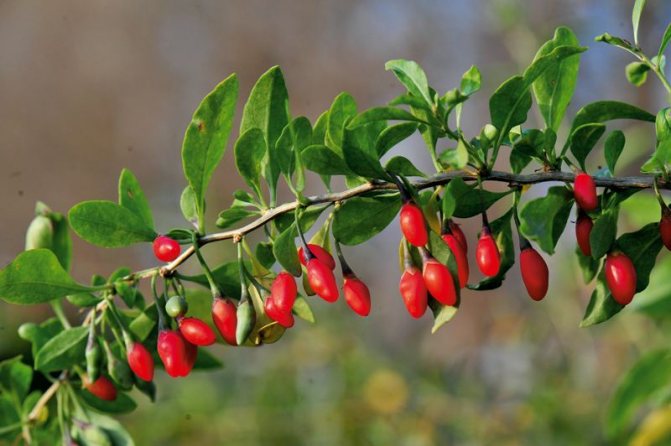

Reproduction of wolfberry takes place in several ways:
- Seeds. This method is the most popular. Dereza seeds can be purchased at any flower shop, or it is possible to collect them at your summer cottage. If you plan to sow planting material in open soil, it is recommended to carry out a stratification procedure for the seeds. If sowing is carried out in a greenhouse, then stratification can be dispensed with. Seeds are planted in greenhouses in the spring. Sprouted seedlings pinch. This allows you to increase the number of shoots on one crop bush.
- Vegetative method. In this case, reproduction takes place with the help of small cuttings, the length of which does not exceed 100 mm. Shoots that are selected for planting must be semi-lignified or lignified. This improves the survival rate of the culture. Cuttings are planted in greenhouses in the summer. You can buy saplings of common wolfberry in flower shops or from summer residents. To improve the formation of the root system, cuttings can be pre-planted in the fall in containers with fertile soil. Containers with seedlings should be placed on a warm balcony.
- Self-seeding. In this way, Dereza reproduces in the Caucasian fields.
Seed planting
Growing wolfberry by seed method is suitable for experienced gardeners, the technology requires a certain skill. Dried berries are used as planting material. It is recommended to soak them in water 6-8 hours before planting, and then remove the seeds from the pulp. After that, the seeds are soaked for 2 hours in a growth stimulant solution. Sowing technology:
- Fill a deep and wide container with equal proportions of peat and garden soil.
- Deepen the seeds into the ground to a depth of 2-3 cm, sprinkle with a mixture of earth and sand. Water the planting abundantly with warm water.
- Cover the container with foil or glass, put in a warm and well-lit place. Before the first shoots appear, airing should be carried out regularly to avoid root rot.
Dereza shoots appear in 10-14 days, after which the shelter can be removed. Picks into individual pots are carried out when 2-3 true leaves are formed. The roots are actively growing deeper, so the container should be narrow and high.
Transplantation to a permanent place is carried out when there is no threat of night frosts, and the air temperature warms up to a stable temperature in the range of 12-14 ° C.
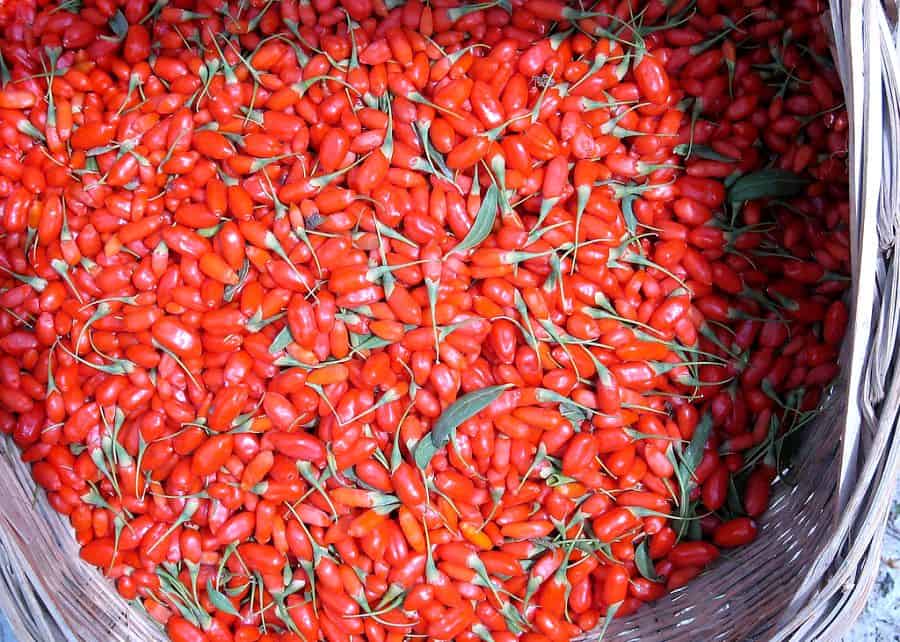

The benefits of the fruit of the common wolf
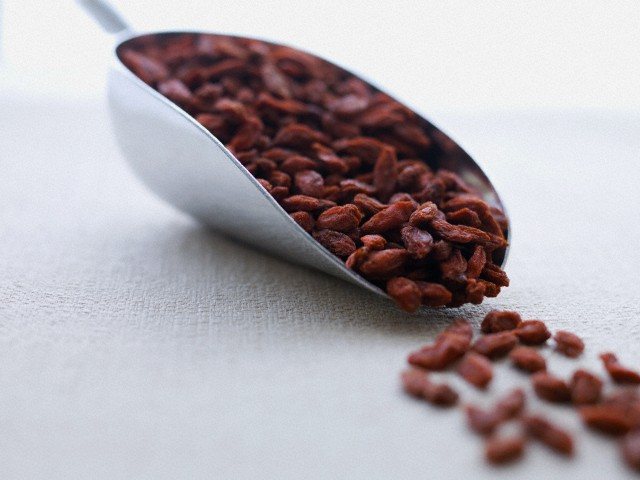

You can talk for a long time about the benefits of the common wolfberry fruit. Therefore, we will focus only on the main points:
- One of the most valuable properties is that the substance contained in these berries helps fight harmful neoplasms. Studies have shown that people who regularly eat wolfberry fruit are less likely to suffer from serious ailments such as cancer, diabetes and Alzheimer's.
- In addition, dereza fruits have a positive effect on the cardiovascular system. The work of the heart muscle is normalized.
- These berries contain a sufficient amount of polysaccharides. Thanks to them, the fruits of Dereza vulgaris have a tonic effect. Eating these berries stimulates the cells to actively perform their functions.
- It contains a valuable adaptogen that gives the body vigor, activity and endurance.
- In addition, these berries can replenish the beneficial intestinal microflora, as well as support its vital functions.
- In addition, the fruit is used to prevent high blood pressure.The beneficial substances in the berries make the walls of blood vessels more elastic.
- Lutein, which is found in the fruits of the common wolfberry, is good for the eyes. In particular, it prevents the appearance of lens pathologies.
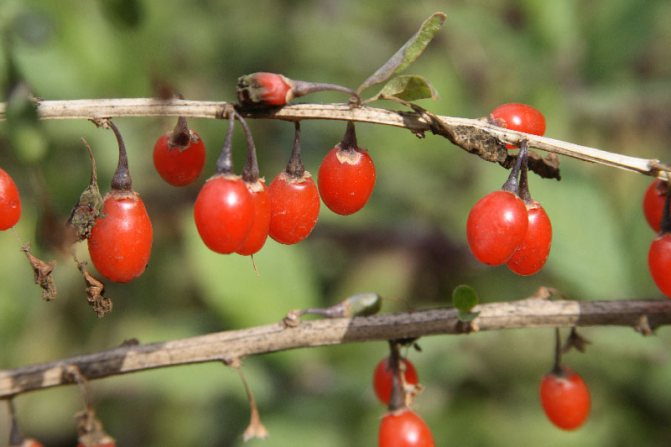

- With regular use of the fruit, excess accumulation of fat cells is eliminated.
- The use of this berry helps to normalize the motility of the gastrointestinal tract, and also helps to remove harmful toxins from the body.
- The phytosterols found in fruits help balance hormones.
- In addition, the use of berries eliminates anemia, mineral deficiencies and raises hemoglobin levels, helps with stress and improves sleep. Therefore, these fruits can be safely called natural remedies for insomnia and depression.
- The work of the brain improves.
- The berries contain lycopene, which activates the immune system, is the prevention of diseases of the cardiovascular system. Improves the condition of the gastrointestinal mucosa.
- Due to the content of glycosides, these berries cause a decrease in blood glucose levels in patients with chronic diabetes.
- They cleanse the blood well and are a means of preventing various pathological processes in cells. At the same time, their aging is delayed.
- It should also be noted that these berries restore in some cases the damaged structure of DNA molecules. This fact has even been confirmed by scientific research. Perhaps it is for this reason that the Chinese who live in the Himalayan regions are considered centenarians.
Growing healthy berries from seeds
Summer residents are wondering about growing goji from seeds. This is because plant seedlings are expensive. On the Internet and in a specialized nursery, seeds are sold from which healthy seedlings can be grown.
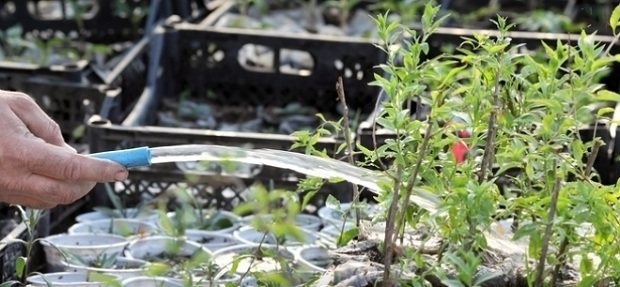

In order to save money, people practice the purchase of dried fruits of the plant on the market. In this case, there is a great risk of being left without a crop, since it is impossible to foresee what the seedling will be like. There is no guarantee that in a temperate climate, he will be able to gain strength.
If the purchased seeds are grafted, then sowing is done simply:
- A box is prepared with a mixture for growing seedlings (nutrient substrate).
- The surface of the earth is moistened. Seeds are laid at the base. No pre-processing is required.
- The seeds are covered with a soil layer of no more than 3 centimeters.
- The landing box is placed in a lighted room.
- For 15 days, the surface of the earth is sprayed daily.
- On the 16-17th day, young seedlings will appear from the ground.
- When the plants reach 7 cm seedlings, they can be planted in garden beds.
After the seedling cotyledon opens, the plant needs to be treated with phytosporin. The event will protect crops from the attack of fungal infections. Subsequent growth is accompanied by fertilizing from mineral fertilizers with a predominance of potassium humate.
Growing wolfberry
Choosing a site for planting wolfberry
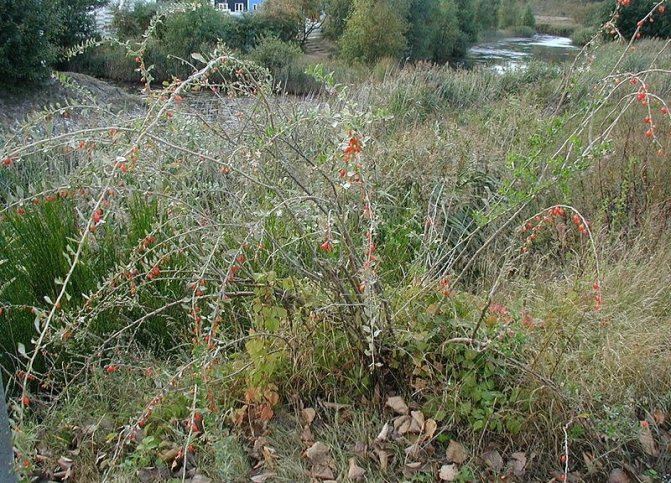

Before deciding to plant this plant on your site, you need to understand that it is quite unpretentious and grows very quickly. If you do not follow it, then it can grow throughout the site, adding inconvenience to other plants. It will be problematic to remove him from the site. Often this plant is grown in wastelands, along ditches and ditches, as well as in apiaries. Any soil is suitable for planting dereza. She feels great even on drained marginal soils. Sufficient sunlight is the only prerequisite for the normal growth of a plant of any variety. Therefore, for planting it, it is better to choose well-lit areas without shade from other trees and plants.
Planting Dereza ordinary
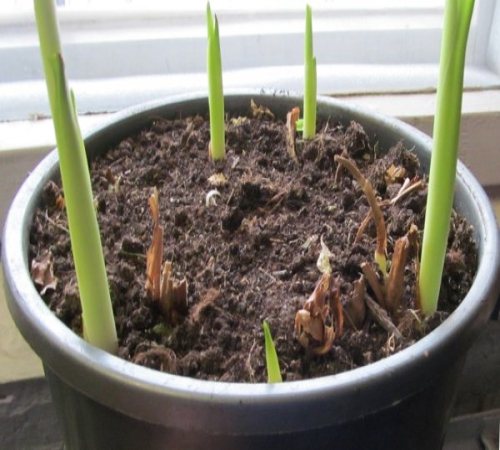

The optimal period for planting this plant is spring. It is rarely planted in autumn, although it can endure slight frosts.In the southern regions, where the temperature rarely drops below zero in winter, autumn planting is possible. The wormwood plant should overwinter in a shelter. It is unpretentious in the choice of soil, but gives the best results on slightly acidic-strongly alkaline soils. In this case, the site should be well lit by the sun's rays.
The order of planting the common wolfberry:
- To plant a wolfberry seedling, it is necessary to prepare a hole 0.4 m deep and about half a meter wide.
- Before planting, the pit is watered abundantly with water and mulched with humus or peat.
- After planting a seedling of a plant, which needs to be buried a little, the soil is prepared for backfill. To do this, mix 30-45 g of potassium sulfate or wood ash, 150-230 g of superphosphate and up to 8 kg of compost with the ground.
- It is necessary to plant Dereza seedlings with a small gap so that they do not interfere with each other's development. The optimal distance between holes is 1.5 - 2 meters.
Choice of place and conditions of detention
Goji is a fast growing shrub with a strong root system. Suitable for creating a hedge, but it is better to plant the plant in an empty area to avoid darkening undersized crops. Dereza prefers a well-lit place, but grows and develops comfortably even in the shade.
The plant is unpretentious to the quality and composition of the soil. For planting, it is best to choose a place with a loose and light substrate with high aeration, the plant grows slowly in lowlands, rocky areas.
The soil should have a neutral or slightly alkaline reaction; with increased acidity, the decorative effect of flowering is significantly reduced.
Dereza vulgaris: care
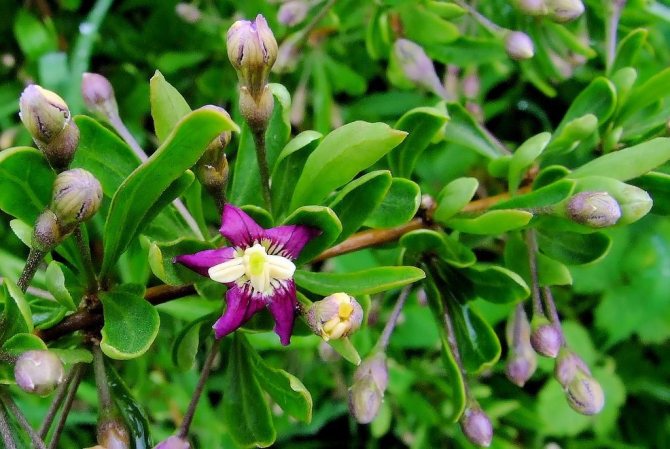

- The plant in the process of its growth does not require special care and grows by itself. It should not be watered abundantly, even if the summer is dry. It requires abundant watering only during planting. Otherwise, watering once a week will be sufficient.
- The plant needs feeding only during the growing season. In other cases, Dereza develops quite normally without fertilizers, because it takes root well on poorly fertile soils.
- The plant is quite resistant to scraps. Young shoots grow quickly in place of the cut branches. Mechanical pruning, which is often used in ornamental gardening, will not harm the tree.
- With severe frosts in mid-latitudes, the plant may freeze and die. To avoid this, it is sheltered during the winter. Cover them with spruce branches or polyethylene. This creates an optimal microclimate inside with low frosts. If the winters in the region are very harsh, many gardeners transplant the crop into deep containers and store it in a warm room.
How to grow goji berries
Landing rules
Facial care after 50 years: advice from a beautician
It is best to plant this plant along the fence, as a hedge. It is advisable that there are no other greenery next to the shrub in the garden.
Goji berries planting and care in the open field:
- the plant loves the sun;
- tall shrub needs support;
- it is advisable to choose a soil with an alkaline reaction;
- stagnant water should be avoided, so rocky ground is not the best option.
It is most convenient to plant with seedlings or cuttings. Pits 50 cm deep are prepared 14 days before the expected planting date. A small layer of humus is placed at the bottom. The seedling is carefully lowered into the hole, after having straightened the roots, covered with a layer of fertile soil, then watered.
The trunk circle needs mandatory mulching, otherwise the plant may not take root. It is best to use peat for mulching. Goji is a plant that loves space, is tall and has a spreading crown, so the seedlings should be about 2 meters apart.
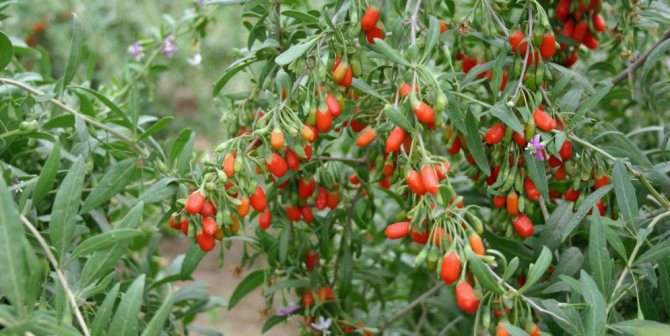

In open ground, goji berries are best planted in a sunny area.
Care
The shrub must be groomed regularly.Home care consists mainly of watering and feeding. A gardener who grows goji berries should know: the plant needs moderate watering, without excess moisture.
Goji berry planting and care:
- planting material should be purchased only in nurseries, in order to avoid deception;
- when planting from seeds, it is necessary to use a growth stimulator;
- a plant under one year old is watered twice a week;
- superphosphate is used for feeding;
- mature plants do not fertilize.
Seedlings grow and adapt to the environment faster than young growth from seed.
In order to properly form the crown, it is necessary to regularly prune the plant. To do this, you need to outline the "backbone" of 4-5 strongest branches and remove all the rest of the growth, then the plant will be strong and healthy. In preparation for winter, the shrub must be spud and mulched to prevent the roots from freezing. If the winter is with a lot of snow, the berry bush usually tolerates winter well.
In areas with a warm climate, goji seedlings are planted in the ground in the fall, in the north of the country - in the spring.
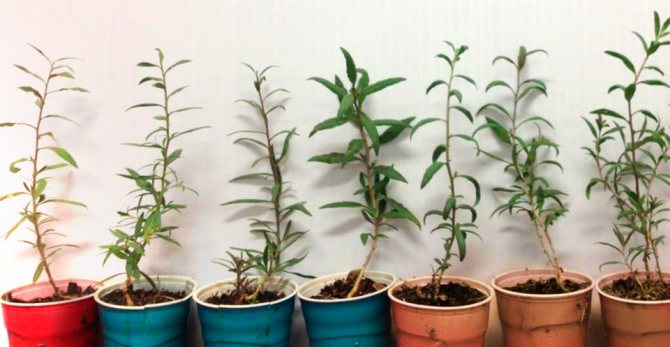

Saplings adapt outdoors faster than seed-grown plants
What is suitable for use?
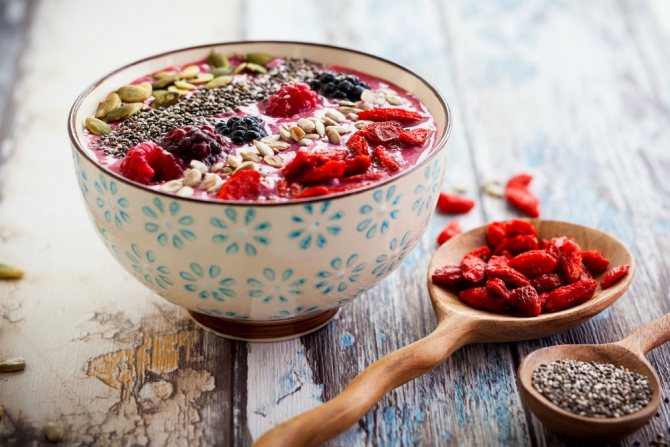

Healthy breakfast
Component plants suitable for use:
- Fresh fruits are hazardous to health, because their use is fraught with poisoning. After drying, they lose their toxic properties and are suitable for consumption.
You can eat dry berries only in limited quantities. The recommended daily dose is no more than 45 g. They begin to take in a small amount (several fruits per day). Over time, the dose increases to 10 g.
You can immediately use the maximum dose only after consulting your local doctor.
Reception is carried out in 2 approaches: half a portion in the morning on an empty stomach, the remaining half in the afternoon. Drinking after 18.00 is not recommended, because the tonic properties of the berry can provoke insomnia.
There are several options for how you can eat the dried crop:
- like dried fruit
- brewed
- with addition to various dishes (cereals, ice cream, salads, baking stuffing)
- in the form of juice
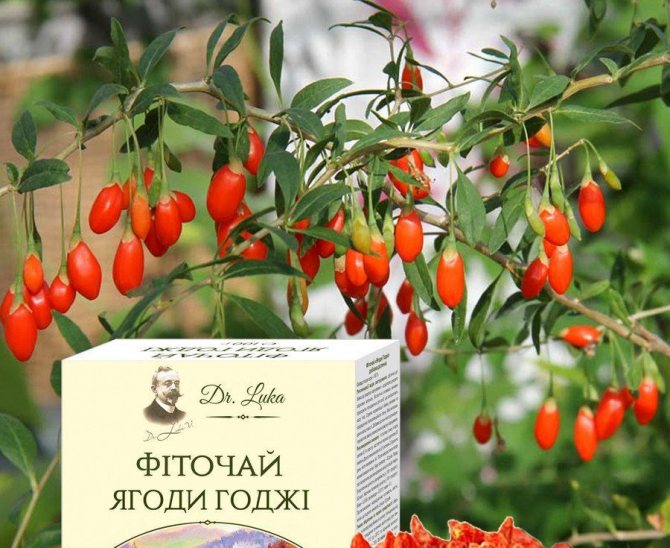

GODJI BERRIES FITOCA
To prepare a decoction of 45 g of raw materials, 0.5 liters of boiling water is poured and infused for half an hour. 1/3 cup is taken 3 times a day.
You can also insist the fruit on alcohol. For this, a handful of raw materials are poured into a dark glass container and 1 liter of alcohol is poured. Infused for 1 week. It is taken at 20 ml per day, diluted with water.
- The bark of the roots also has medicinal properties. It is indicated for use in the treatment of cough, fever, to lower blood cholesterol levels, as a diuretic and laxative. Accepted in the form of decoctions
To get the product, the roots are dug out, washed, peeled from the bark and dried well in the sun.
- The leaves are used to make tea, which has an invigorating effect. It is necessary to cut them off when the plant is in bloom and dry. The leaves can be stored for 1 year.
Goji is an exotic plant, so its fruits and other components may be unusual for the body of our compatriot. Excessive enthusiasm for this plant can lead to kidney problems and severe dehydration.
back to menu ↑
Botanical description of Goji
Goji is a culture from the Solanaceae family. It is a lignified, deciduous shrub that grows up to 3.5 meters in height. The bush has a wide crown, about 6 meters in diameter.
Goji's root system is quite powerful. The roots are able to penetrate into different layers of the soil, thereby forming a large number of root suckers.
The branches are drooping, yellow, covered with many thin thorns.Leaves are simple, whole-edged, elliptical in shape. The upper part of the leaf plates is green, the bottom is light gray.
Goji flowers in the form of bells, painted in pink-violet, brown-violet or purple. The flowers exude a pleasant mild aroma.
The fruit is an oblong orange, coral-red or crimson berry. The length of one berry is 2 cm. Fruiting of the bush begins, as a rule, from the third year of growth.
Berries for weight loss
The fruits of the common wolfberry are a faithful and reliable assistant in the fight against extra pounds. The optimal dosage for losing weight is from 20 to 50 grams of berries throughout the day. The indicated amount of the product should be divided into several receptions. But how to prepare the preparations correctly?
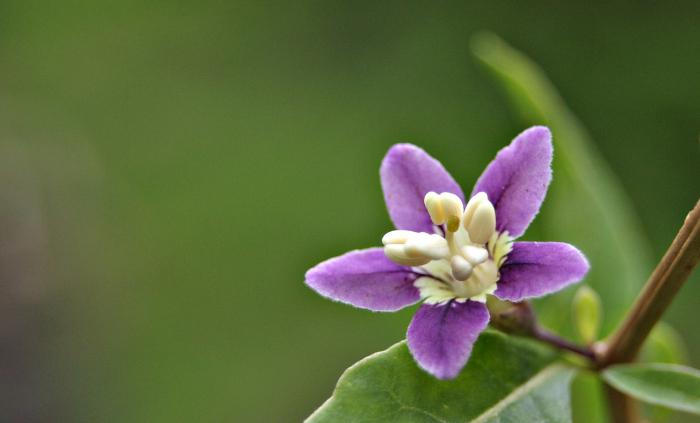

Infusion
This remedy has the greatest effect. For cooking, you need to pour 250 milliliters of boiling water over a tablespoon of the fruit and let it stand for half an hour. The finished drink can be taken up to three times a day in a tablespoon.
Tincture
You can prepare a tincture from the fruits of the common wolfberry. To do this, you need to pour 50 grams of berries ½ liter of vodka. The container with the drug should be tightly closed and placed in a dark place. The remedy should be infused within 7 days. The finished elixir can be taken twice a day for 10 milliliters, diluting the drink with water.
Porridge
To prepare the dish, you need to take several glasses of water, 5 grams of berries and a tablespoon of rice, preferably dark. It is necessary to cook porridge until cooked. At the same time, you cannot add spices to dishes.
Soup
It is best to cook wolfberry berries with liver. Such a dish will be more useful in the fight against excess weight. For cooking, boil 50 grams of fruit and 100 grams of liver. The finished dish should not be seasoned with spices. You can add a little dry or fresh herbs mixed with various herbs to it.
Preparing for the winter period
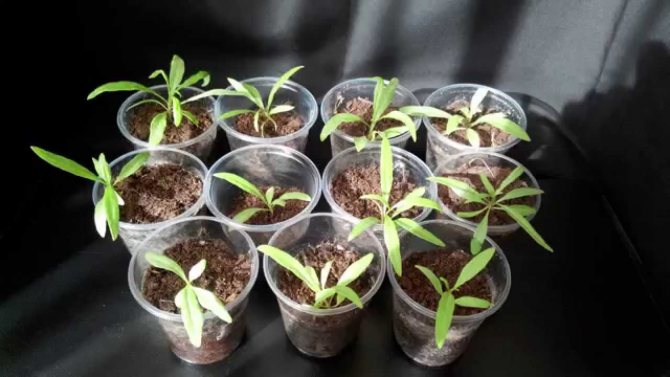

Goji landing
Despite the fact that there are varieties that are able to withstand cold temperatures (-15 ... -250C), for safety reasons, it is still worth preparing them for the upcoming low temperatures. To do this, in the fall, the shrub is covered with spruce branches. This will protect it from freezing if little snow falls in the winter.
Varieties that are not resistant to frost are dug up together with the soil in the autumn and transplanted into containers of the required size. The shrub is stored in the basement with stable low above-zero temperatures.
back to menu ↑
Application and storage
The harvested fruits should be stored in a dry, dark place. If an infusion is being prepared, then it should be kept only in a cool place and no more than 2 days.


Goji berries are used not only for weight loss, but also as an ingredient in the preparation of wines, fruit purees, desserts, soups, pastries, yoghurts, tea, juices, cereals. The seeds are used to make oil. Fresh berries taste like nightshade. But as soon as the fruits are frozen or dried, the taste disappears, and the berries acquire a taste similar to dried apricots.
In the garden, wolfberry is mainly planted to obtain a useful harvest, as well as vegetable hedges. The plant is unpretentious and will not die if you have not watered or applied fertilizer. But, when planning to plant goji berries on the site, you should consider all varieties in advance and choose the most suitable ones.
Berries are widely used in medicine. So, they are taken for: pain in the back, diabetes, insomnia, anemia, obesity, excess cholesterol, problems with adenoids, vision problems, athletes thus restore their strength, etc.
As you can see, although goji berries are an exotic shrub, you don't need to go to overseas countries or buy them at a fabulous price. It is enough to observe some of the nuances, and you can easily grow a plant in your area and collect a very considerable harvest.
Harvesting
Goji berries cannot be picked by hand like raspberries or currants due to their large and sharp thorns. For this, another method is used: they spread a cloth or film under the bush and knock the berries down with a stick, protecting the hand with clothes with sleeves and gloves.
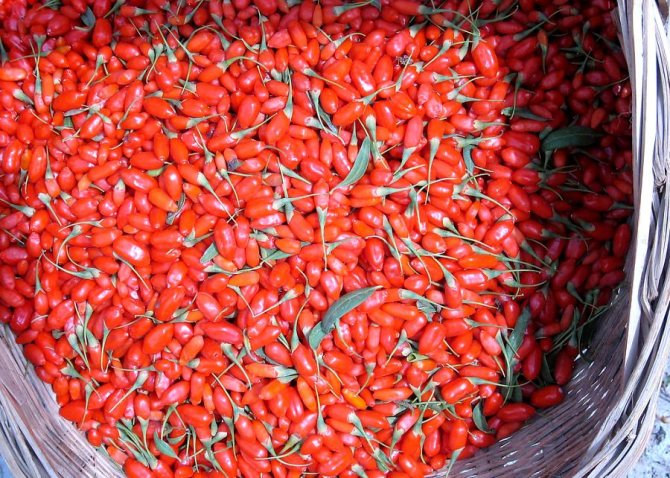

A bountiful harvest
Then the collected fruits are sorted out, removing debris, leaves and twigs, and scattered to dry in the shade under a canopy. After a few days, the stalks are cut off from them and the drying continues, periodically stirring the berries.
A sign of readiness for storage is peeling of the skin, which is easily separated from the fruit. They are poured into ceramic or glass dishes and tightly closed with a lid.
Some of the fresh berries can be frozen for use in drinks and pie fillings.
Components included
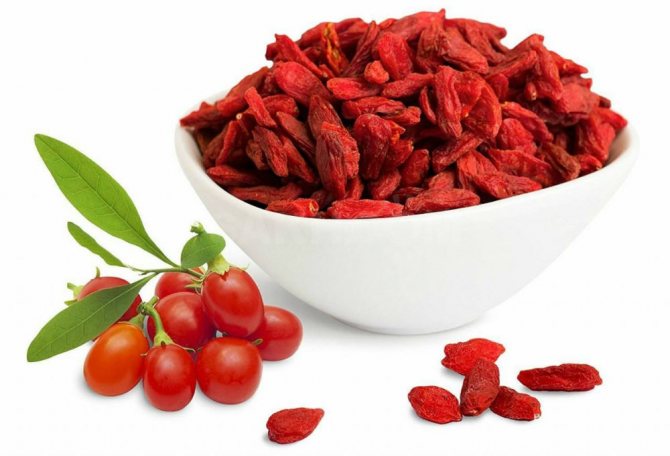

A treasure trove of vitamins and useful elements
Lycium barbarum contains the following beneficial vitamins and minerals:
- beta carotene
- thiamine (B1)
- riboflavin (B2)
- pyridoxine (B6)
- ascorbic acid (C)
- calcium
- phosphorus
- iron
In addition to the above, it has other components:
- phenols
- phytosterols
- mono- and polysaccharides
- amino acids (lysine, tryptophan, threonine)
The number of calories per 100 g of product is 253 kcal.
In the dried berry, the content of ascorbic acid is minimal, for this reason, the antioxidant effect on the body will be negligible.
back to menu ↑
See also: Blackberry: a description of the 17 best varieties, cultivation features, reproduction and care (30 Photos) + Reviews
Growing goji at home - diseases and pests
The shrub is not only unpretentious to care for, but also resistant to the effects of various diseases and pests. Young shoots are rarely damaged by aphids, and the Colorado potato beetle can be seen on flowers and young ovaries. When growing goji berries, powdery mildew may appear during rainy periods. You can cope with pests by spraying with wormwood infusion. Diseases, for example, late blight, manifest themselves with poor care or the choice of the wrong soil. As a preventive measure, chemical treatment is not necessary.
Goji seedlings from cuttings
How to grow goji berries on the plot of your own summer cottage? You can grow a wolfberry seedling from seeds or from a cutting.
Cuttings can be obtained using layering. To do this, in the middle of summer, on an already existing bush, not younger than three years of age, they are bent to the ground and buried in strong branches. Before the first frosts, the branch is cut and planted.
Cuttings can be cut separately. Cuttings about 10 cm long are carefully cut from the mother bush, and it is imperative to cut them so that at least 1 cm is "old" wood. The edge is processed with root root, and the cuttings are planted in the greenhouse. In winter, an insulated balcony is also suitable for this.
Types and varieties of goji
As we have already mentioned, the common wolf, or goji, is a species of the genus. There are two known varieties of this species:
Dereza Tibetan (Lycium barbarum)
or tibetan goji - a high-yielding form of a plant that begins to bloom and bear fruit in the first year after planting. Tibetan goji berries are drop-shaped, up to 2 cm long, sweet, with a tangible aftertaste of nightshade. The disadvantages are watery fruits and too large seeds.
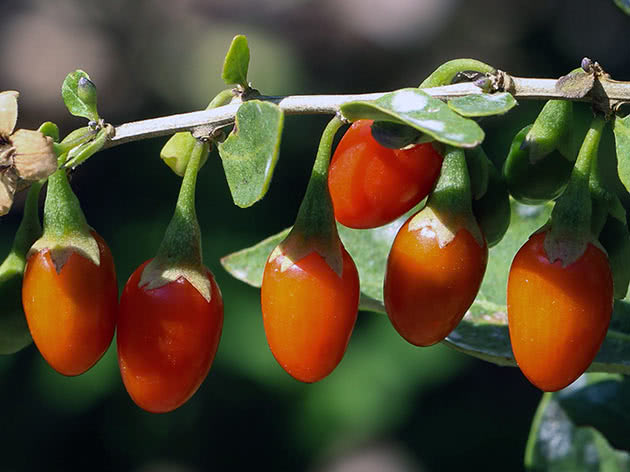

In the photo: Tibetan Dereza (Lycium barbarum)
Chinese Dereza (Lycium chinense)
or chinese goji Is a taller and stronger plant with elongated, crispy sweet berries that are pleasant to eat and easy to dry. Disadvantages: late entry into fruiting and low winter hardiness.
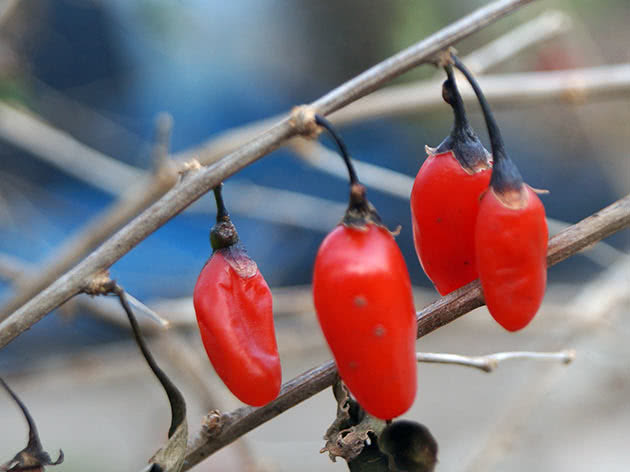

In the photo: Chinese Dereza (Lycium chinense)
Recently, the common wolfberry has appeared varieties of interest to gardeners:
- Cherries: diseases and pests, how to treat
- New Big Is an unpretentious, fast-growing and frost-resistant Polish variety that yields its first fruits already in the year of planting. The taste of bright orange berries is sweet and sour;
- Lhasa - an early frost-hardy fruitful variety of the Chinese selection up to 3 m high with arched branches strewn with thorns. The plant begins to bear fruit in the second year after planting. The flowers are violet, self-pollinating, the fruits of a rich orange color, oblong-ovate, up to 2 cm long and weighing 2-3 g. The flesh is sweet-sour with a barely noticeable bitterness;
- Sugar giant - sprawling, fruitful and frost-resistant shrub up to 3.5 m high with surprisingly tasty fiery orange berries up to 2.5 cm long. This variety is called Tibetan barberry;
- Sweet Amber - a frost-resistant, but thermophilic Chinese variety, bred in 2019, but very quickly gained popularity. This plant does not cling to supports, but rests on them. In height, this fast-growing bush can reach 2.5 m, and its berries, when ripe, become amber-transparent;
- Superfruit - lush light-loving shrub up to 3 m high with rich red fruits. Fruiting begins three years after planting.
How to harvest fruits
Since birds love to eat these berries, they have to harvest every couple of days.
Harvesting is best in dry weather. The juice of the berry can provoke irritation of the skin of the hands, therefore it is necessary to work with gloves. Spread a piece of linen or oilcloth under the bushes, and then shake the branches and the ripe fruits will fall off.
To get all the necessary properties from the berries, without exception, you should process them correctly. Place freshly harvested fruits in a dry, impenetrable room and wait until dry. The peel cracks and flakes. Take your time and do not speed up drying. No need to use a stove or any electrical appliances. Let the berries dry naturally. So the dried fruits will preserve their qualities throughout the year. Then you will need to update vitamin reserves.
Collection and drying of berries
Since unripe goji berries can cause poisoning, only the ripe fruits of bright red color are harvested. Dereza juice is quite pungent, so it is better to do it with gloves. You can also simply knock the berries off the bush by placing a piece of clean material underneath.
In order for the toxic substances contained in the berries to be completely destroyed, they must be thoroughly dried. They do it in a natural way, without the use of ovens and preservatives. You can understand that the berries are ready for use by the condition of their skin: it should begin to peel off easily.
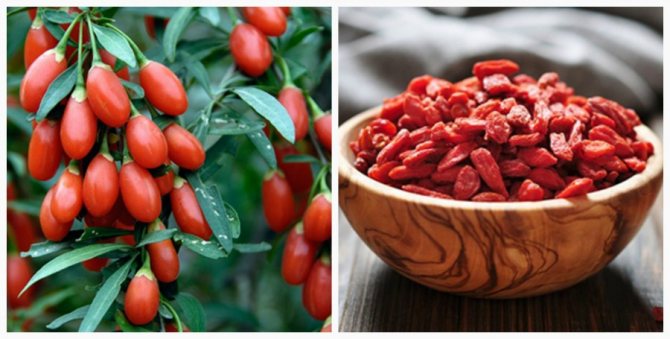

Also, for medicinal purposes, you can use the roots and leaves of the common wolfberry. Decoctions from dried root bark are used to treat colds and fevers, with high cholesterol levels, as well as a laxative and diuretic, and a tonic tea is brewed from the leaves.
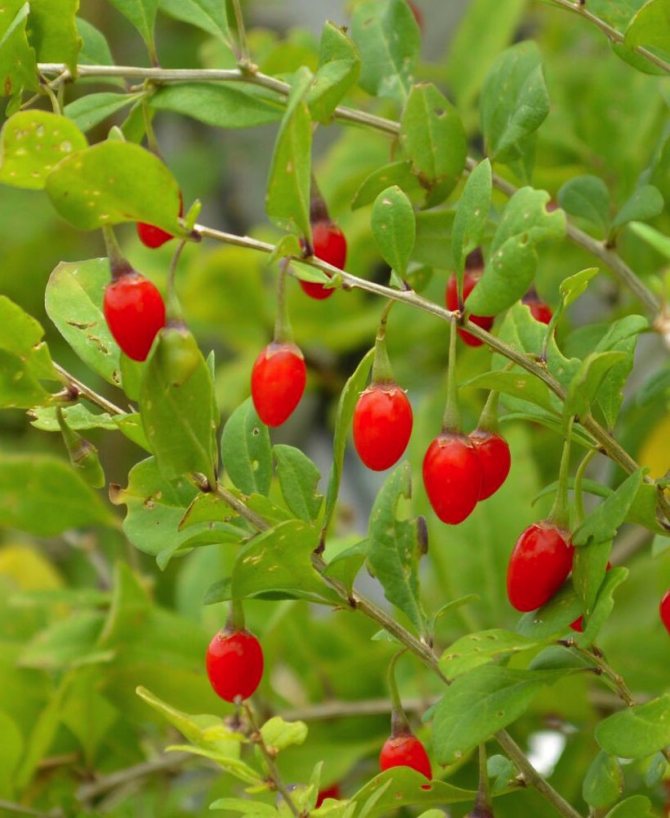

Fertilization
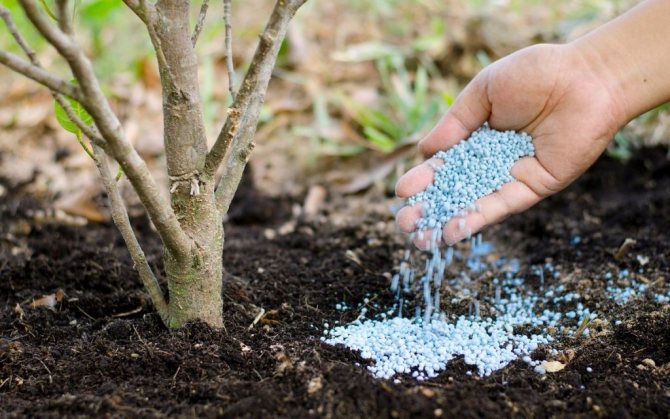

Fertilization in spring
Young plants do not need fertilization during the next year, because the nutrient layer introduced at the time of planting will be enough for it for normal development. In the future, it will be necessary to regularly introduce nutrient complexes into the soil around the bush. It can be an organic fertilizer (for example, mullein at the rate of 5 l / m, humus) or a complex of mineral elements:
- superphosphate - 10 g
- potassium sulfate - 10 g
- ammonium nitrate - 10 g
back to menu ↑
Temperature regime
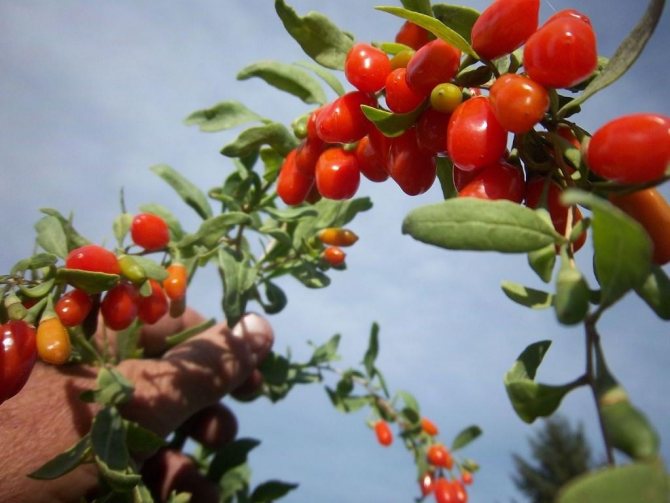

Goji plant
The plant has good frost resistance. It develops normally at a temperature range of -26 ... + 400C. Not demanding on the level of humidity. With calmness refers to the arid climate.
back to menu ↑
See also: Gooseberry: a description of the 20 best varieties with photos and gardeners' reviews about them
Beneficial features
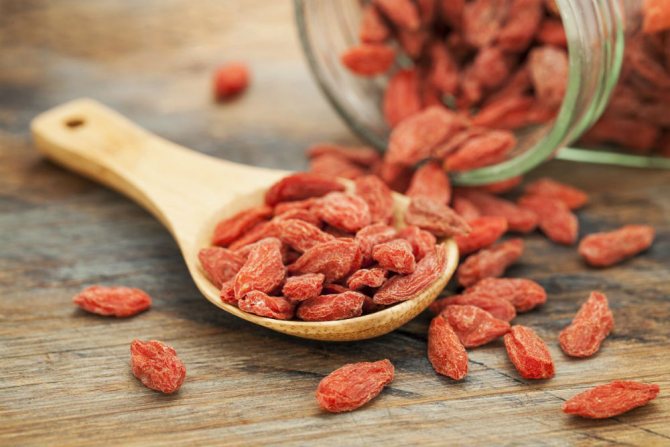

Beneficial effect on the whole body
The plant has a beneficial effect on the body. These are the following properties:
- normalization of blood pressure
- lowering cholesterol levels
- increased immunity
- obstruction of the development of tumors
- improving brain function
- improvement of lymph condition
- stabilization of the level of sex hormones and treatment of infertility
- help for losing weight
- improving the elasticity of blood vessels and muscles
- normalization of glucose levels
- restoration of the genital organs
- increased metabolic processes in the body
back to menu ↑
See also: Kalina Krasnaya berry: and its beneficial properties and contraindications, as well as 13 folk recipes + Reviews
Contraindications
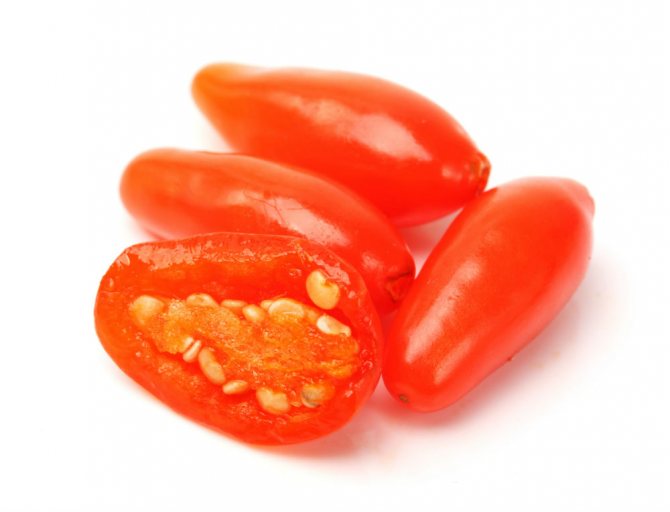

Useful does not mean safe
Despite the great benefits of berries, their use is unacceptable with the following indications present in a person:
- individual intolerance and predisposition to allergies
- pregnancy and lactation
- children under 3 years of age
- gastrointestinal diseases
It is forbidden to use the fruits at the same time as medicines (sleeping pills, anticoagulants).
Compulsory consultation of the attending physician for the following diseases:
- diabetes
- hypertension
- hypotension
- bleeding disorder
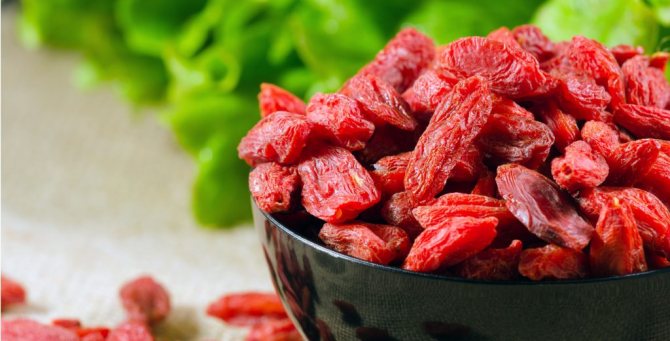

Goji berries
If you exceed the recommended dose, the following side symptoms may appear:
- headache
- nausea, vomiting
- weakness
- insomnia
- diarrhea
In these cases, it is necessary to urgently stop the use of berries.
back to menu ↑
See also: Barberry: description, types and varieties, planting in open ground, care, features for different climatic conditions including Siberia (65 Photos & Videos) + Reviews
Contraindications to the use of wolfberry berries
Exceeding the recommended dosage when using Dereza vulgaris can cause symptoms of poisoning. Also, you can not take:
- for diseases with high fever
- with individual intolerance
- if you are allergic to pollen
- for problems with blood pressure and impaired carbohydrate metabolism
- in the presence of pathologies of the respiratory system, such as asthma, shortness of breath
- with increased gas production in the intestine
- pregnancy
- for children under three years of age
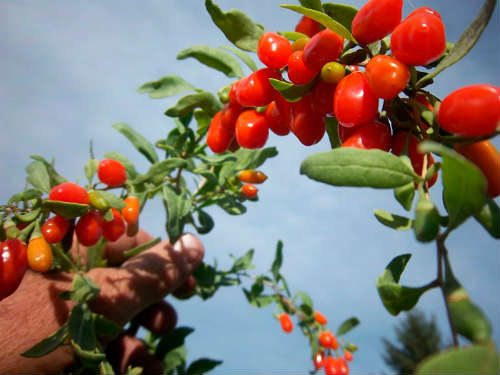

Dereza vulgaris is a valuable medicinal plant. It has a unique chemical composition that includes vitamins, trace elements, biologically active substances, steroid saponins and phenolic compounds. You can take berries for the prevention and treatment of diseases, for weight loss, or simply instead of pharmacy vitamins to improve overall well-being. The main thing is to adhere to the recommended dosage and then the plant will only bring health benefits.
Specificity for different areas
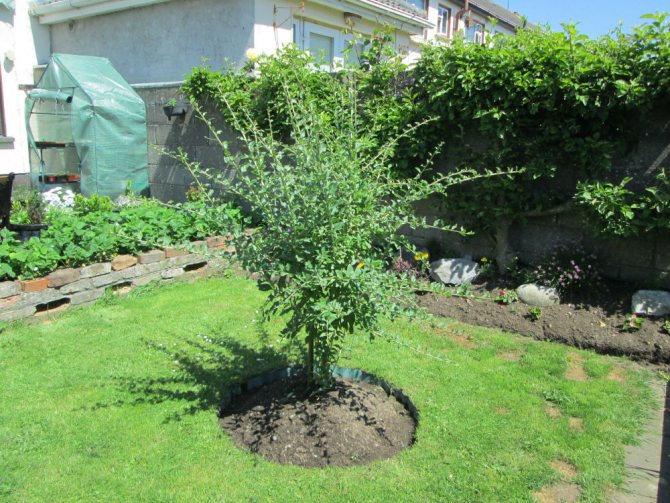

Regular pruning creates a colorful look
The shrub can grow in any part of Russia. He adapts well and develops even in not the most favorable conditions for him. It is especially sensitive not to strong cold, but to the level of moisture in the soil and atmosphere.
back to menu ↑
Moscow suburbs
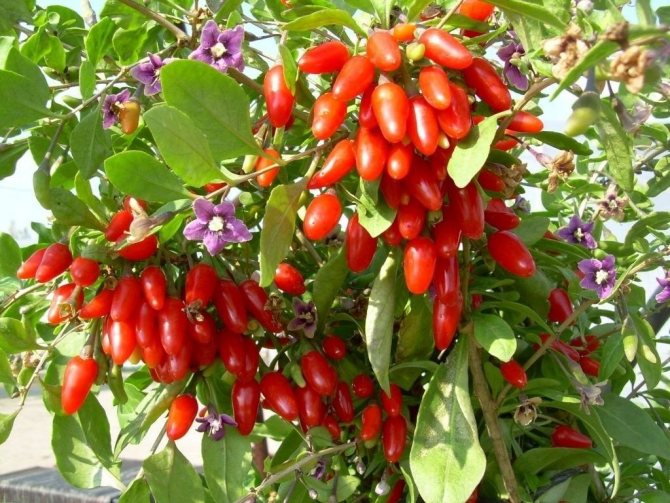

Goji
It is not difficult to grow goji in this region. You don't even need to cook it, sending it for the winter. The main thing is that it should be covered with a lot of snow. Additional protection may only be needed for young seedlings that have been grown from grains. Any organic material can be used for mulch.
back to menu ↑
Siberia
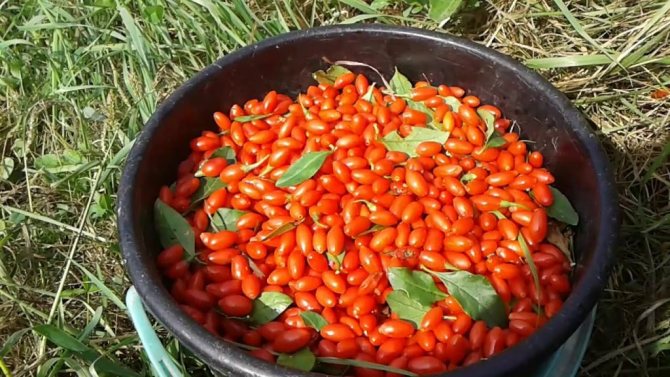

Goji berry picking
This is a very harsh land. For this reason, the wolfberry needs thorough protection from the winter conditions of Siberia. For areas with high humidity, transfer to a container and storage in a cool basement, veranda, or glazed balcony is recommended. It is very important to provide adequate lighting.
back to menu ↑
Ural
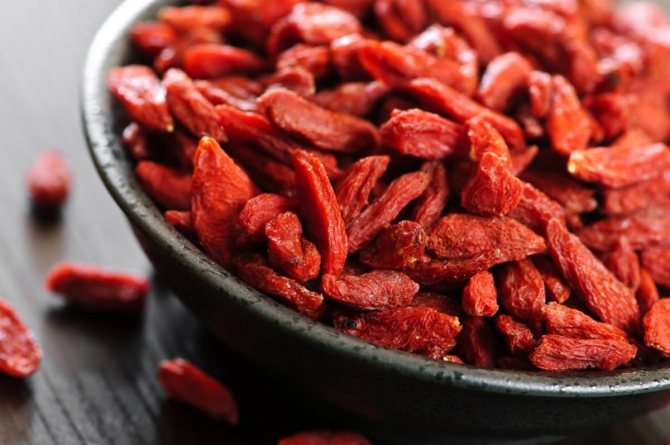

Goji berries
Winter in the Urals is no less severe, although precipitation is very large. It will be quite enough to cover the young shoots with a layer of spruce branches and cover them with snow on top. This will help them to spend the winter without any problems. It is important to keep the bushes out of the water when the snow starts to melt.
back to menu ↑
Leningrad region
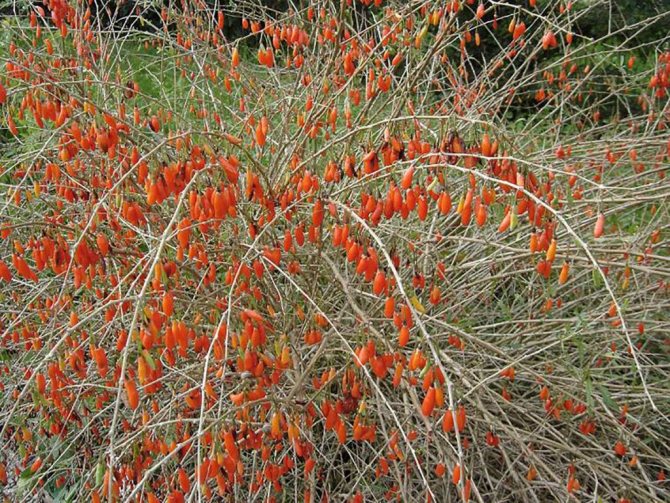

Goji berries in the country
The winter period in this area is cold, humid, and the soils are mostly marshy. At the time of planting, you need to worry about a good drainage layer. This will avoid many care problems. The choice of location is also of great importance. It is desirable that it be a hill. A standard coating for cold weather will help (subject to all the rules when planting a shrub) to survive the moments of very severe frosts for the plant.
back to menu ↑
Mulching
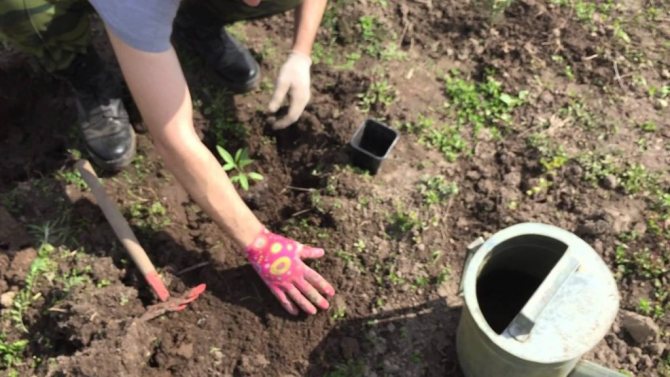

Goji seedlings
To preserve moisture around the seedling and its safety from possible sudden cold snaps, the first year it is recommended to lay mulch material (peat, sawdust) in the area of the trunk circle. The thickness of the mulching layer is 5-7 cm.
For cold areas, the soil is also sprinkled in the winter. This will help prevent hypothermia.
back to menu ↑
Bush care
Dereza especially needs care after planting - during the first two years. In subsequent years, the care of an adult plant will be minimal.
It is not difficult to take care of the bush: it is watered, sometimes fed and necessarily cut off.
Watering rules
The soil should be moderately moist, so water it sparingly so as not to harm the roots. With prolonged rains and low temperatures, it is advised to cover the trunk of the bush with a special covering material. If the weather is dry for a long time, watering is carried out more often.
Types and methods of feeding
The first top dressing in the open field is carried out at the time of planting. Mineral phosphorus fertilizer and humus are introduced into the hole. The next spring, the plants can be fed with organic matter. Complex fertilizers from the store are also suitable.
Pruning features
Goji is an actively growing shrub, its height can reach 4 m. If you do not restrain it, soon the bush will be able to fill the surrounding space. Annual pruning of the branches will not only preserve the decorative appearance of the shrub, but also improve its yield - larger berries grow on the pruned bushes. When pruning, the strongest branches are left, of which young shoots will then begin to develop. The formation of a bush for decorative purposes is carried out around one selected shoot.
Ways to control pests and diseases
Despite its resilience and ability to survive in harsh conditions, wolfberry is rarely attacked by harmful insects. Most often, aphids are noticed on the leaves of the bush. In some cases, the Colorado potato beetle and scoop are found. To eliminate them, use a concentrated solution of wormwood. High humidity can provoke powdery mildew on the leaves. As a treatment, treating the leaves with soapy water is suitable.

